Oregon is famous for its rich avifauna – there are almost 550 bird species there with a number of those being very active during the night! These nighttime birds can stay safe from daytime predators, hunt for food in the dark, and use the unique conditions of the night to their benefit.
Examples of nocturnal birds in Oregon include the northern mockingbird, barn owl, spotted owl, yellow-breasted chat, Wilson’s snipe, and many others.
Do some of them sound familiar? Let’s jump in and see what each of these looks and sounds like!
Table of Contents
Night Birds In Oregon
1. Wilson’s Snipe
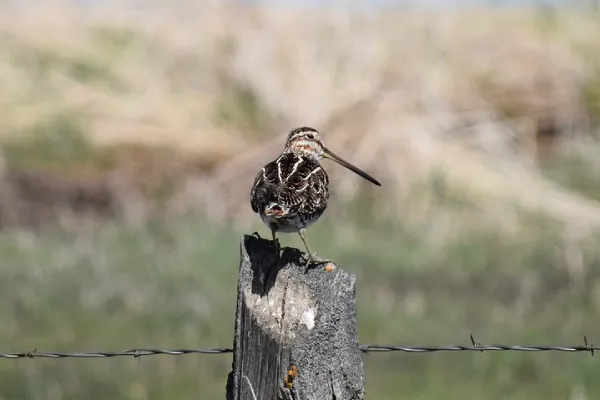
- Scientific Name: Gallinago delicata
Wilson’s snipes prefer wet grassy fields, sedge marshes, and bogs. They are permanent residents in Oregon and their activity peaks during dawn and dusk.
To locate them, listen for their “tuk-tuk” call, which can be heard from the ground or low perches.
Wilson’s Snipe Call | Source: Doug Hynes, CC BY-SA 4.0, via Wikimedia Commons
Their winnowing display flight is also very interesting and can be heard overhead. Males will fly high in circles and then take shallow dives to produce a distinctive sound. This behavior can be spotted during the day and long into the night.
2. Flammulated Owl

- Scientific Name: Psiloscops flammeolus
Flammulated owls are unique among small owls due to their completely dark eyes and low hoots.
These tiny reddish birds are just 6 inches long and span around 14 inches across the wings – such large wings allow them to quickly move from one tree to the other. Females are longer and bigger than males – the species were named after the flame-like markings on their faces.
Flammulated owls breed in the Cascades’ eastern slope, the Blue and Wallowa Mountains, and some southwestern Oregon mountains. You can hear them most actively singing just after dark and near dawn, less in the middle of the night.
Because of the long trachea (windpipe), flammulated owls make low-pitched single or double hoots that sound like much larger owls made them. The Cornell Lab of Ornithology describes their repeated hoots as “ventriloquial” since it is almost impossible to locate the bird from the sound.
3. Western Screech-owl
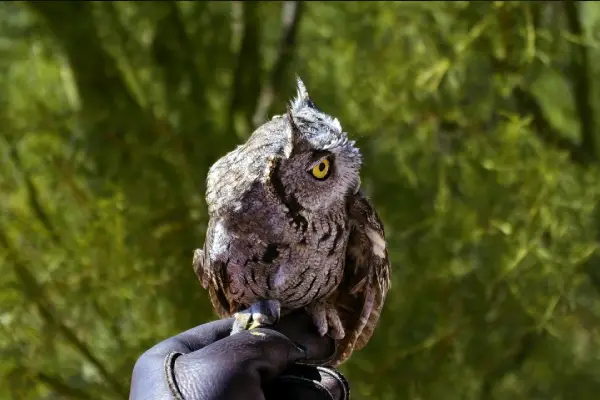
- Scientific Name: Megascops kennicottii
These small owls with stocky bodies have gray plumage with black and white streaks, short ear tufts, and yellow eyes.
Western screech-owls are common year-round in lowland woodlands across the state. They’re often seen below 3,000 feet in western Oregon but have been spotted up to 4,100 feet in the west Cascades.
Part of their scientific name “kennicottii” is after the American naturalist Robert Kennicott.
The species are nocturnal, often seen sitting on perches before swooping down and catching their prey. They mostly feed on insects, small mammals, and birds – listen for their series of whistled notes that accelerate at the end and that are given at night.
Western Screech-owl Call | Source: FR, CC BY-SA 4.0, via Wikimedia Commons
Western screech owls can be found in different wooded habitats, but mostly prefer riparian and deciduous areas; also urban areas and parks.
Read More: Sounds of common night birds in Alabama?
4. Great Horned Owl

- Scientific Name: Bubo virginianus
Great horned owls are one of the biggest birds in Oregon. They measure almost 2 feet long, weigh up to 3.5 pounds, and can be found throughout the year in the state.
Great horned owls are most commonly encountered owls in Oregon; keep in mind that they have dark brown plumage in western Oregon and pale grayish brown in southeastern Oregon.
These owls prefer open areas like fields and marshes near mature forests. They become most vocal for an hour after dark and an hour before dawn.
Great horned owls make deep, loud “ho-ho-hoo hoo hoo” sounds that can have four or five syllables. The female owl’s call is higher-pitched, and it tends to peak after midnight.
Great Horned Owl Call | Source: Michael & Katie LaTour, CC BY-SA 4.0, via Wikimedia Commons
In winter or spring, they often sing in a duet. Territorial hooting tends to decrease in February or March when they start laying eggs. In summer, the distinctive juvenile begging call can sometimes be confused with the calls of barn owls.
5. Barn Owl
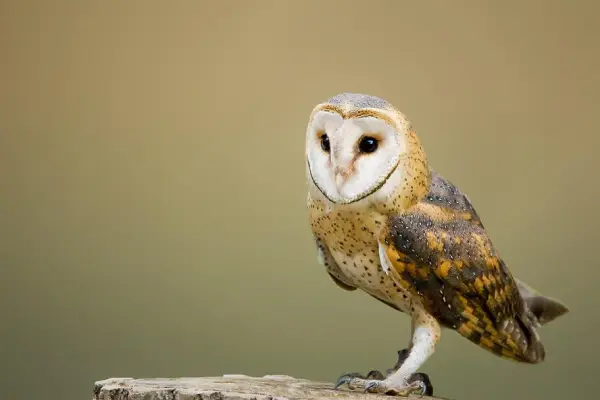
- Scientific Name: Tyto alba
One of the most startling sounds you can hear at night in Oregon is the loud, harsh call of barn owls. These permanent residents of Oregon are fairly common throughout the year in open areas west of the Cascades; to the east, you’ll find them more locally, especially in agricultural regions.
These medium-sized owls have heart-shaped heads, cinnamon and gray upperparts, and white underparts. They often have a “ghostly” appearance, especially if seen at night when they are most active.
Barn owls do not hoot and make bone-chilling screams instead.
Barn Owl Call | Source: Luis Gracia, CC BY-SA 4.0, via Wikimedia Commons
They are quite common in the USA and are among many birds that can be seen during the night in Florida.
6. Barred Owl
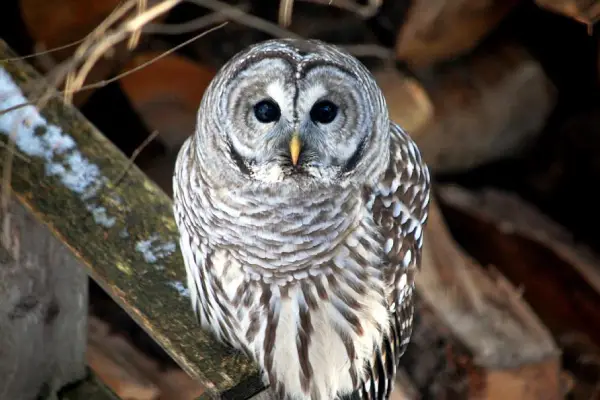
- Scientific Name: Strix varia
First reported in Oregon in the early 1970s, barred owls have since spread to forested areas throughout most of the state. At night, you can listen for their calls in the forests of the Cascades, Coast Range, Blue, Wallowa, Strawberry, Klamath Mountains, and western Curry County.
They are active throughout the night and are known for their “who-cooks-for-you” song and “hoo-ahhh” call. They will duet, and their juveniles make a high-pitched raspy hissing noise, an automatic confirmation if it’s heard in a specific block.
Barred Owl Call | Source: Jonathon Jongsma, CC BY-SA 4.0, via Wikimedia Commons
These massive owls with mottled brown and white plumage can be also identified by their yellow beaks, absence of ear tufts, and large and dark brown, almost black eyes.
7. Long-eared Owl
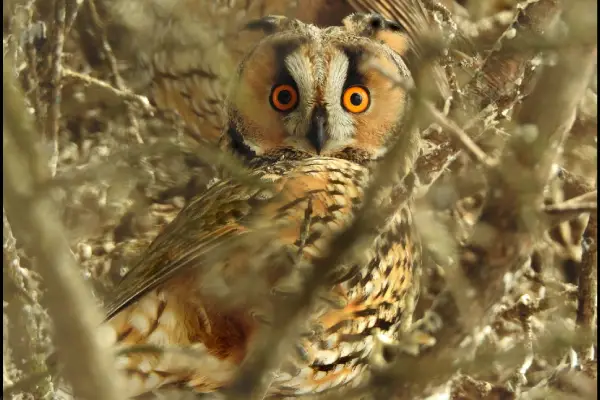
- Scientific Name: Asio otus
Long-eared owls are secretive, nocturnal, and well-camouflaged owls that have gray-brown bodies with pale bars and heavy streaks on their underparts.
Long-eared owls are fairly common breeders east of the Cascades, typically found in open areas near trees and junipers. They’re common in the Boardman Bombing Range of Morrow County and widespread in Malheur County. In the foothills of the Willamette Valley, they’re rare, with only a few nesting records.
They become active shortly after dusk throughout the night. Long-eared owls don’t vocalize often but have distinct calls. The male’s song is a low-pitched series of “hoo” notes, similar to the sound of blowing across a bottle.
Long-eared Owl Call | Source: Alexander Kurthy, CC BY-SA 4.0, via Wikimedia Commons
The distinctive juvenile begging call is also a good indicator, but caution is needed as distant barking dogs or mooing cows can sound like long-eared owls.
Read More: Examples of birds that sing during the night in Michigan
8. Short-eared Owl

- Scientific Name: Asio flammeus
Short-eared owls are found on all continents except Antarctica and Australia, making them one of the most widespread bird species.
Similar to long-eared owls, these nocturnal owls can be seen and heard throughout Oregon year-round, around open grasslands, including weedy fields, grass strips of small airports, coastal marshes, and even agricultural fields with stubble.
Short-eared owls are mottled brown above, whitish below, and have very short ear tufts and black beaks. They also have large yellow eyes that are accentuated by black rings, making them look like they are wearing mascara!
Although mostly silent, short-eared owls will make a series of “voo-hoo-hoo” calls during the breeding season.
Short-eared Owl Call | Source: Jamescandless, CC BY-SA 3.0, via Wikimedia Commons
They are generally nocturnal when most of the hunting happens, but they can also be crepuscular (active near dawn and dusk) and even diurnal (to a much lesser extent).
Read More: Guide on night birds in Louisiana
9. Northern Saw-whet Owl

- Scientific Name: Aegolius acadicus
Northern saw-whet owls are mottled brown with white-spotted heads, whitish facial disks, yellow eyes, and lack of ear tufts. They typically breed in low to mid-elevation forests across the state and can be found at higher elevations, with the Coast Range being a common area for their detection during nocturnal surveys.
The compound called porphyrin makes their flight feathers unique – the pigment gives their feathers a neon pink fluorescence when exposed to UV light.
One of the most common forest owls in Oregon, northern saw-whet owls were named after their loud and repetitive whistles described as “a saw being sharpened on a whetstone”. Their calling peaks around 2 hours after sunset and decreases until just before sunrise.
Listen for the tooting advertising song of males, a repeated “toot-toot-toot.” They give a variety of other calls, and later in the season, juveniles produce a raspy, hissing call.
Read More: What birds chirp at night in Massachusetts
10. Burrowing Owl
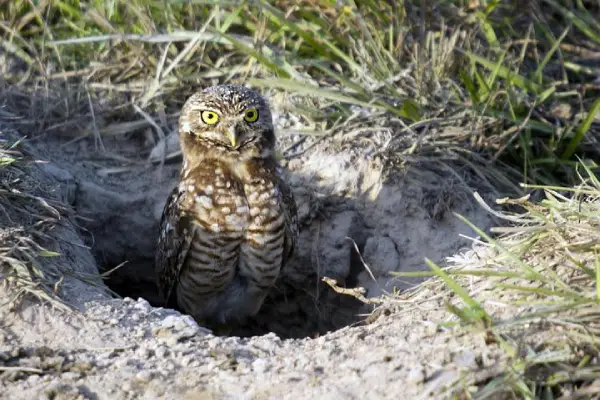
- Scientific Name: Athene cunicularia
Burrowing owls are the only owl species that nest underground.
In spring and summer, you’ll spot burrowing owls in the open grasslands and shrub-steppe areas across eastern Oregon, except in higher mountains. Your best chances of seeing them are in the Columbia Basin and the southeastern part of the state.
Identify them in person by their bright eyes, long grayish legs, and lack of ear tufts. These owls have brown heads and wings with white spots and white bellies.
Burrowing owls aren’t very vocal but will still make various sounds: clucking, screaming, rattling, etc. They will often make a two-note cooing call when mating or defending territory.
In Oregon, you are most likely to hear burrowing owls at night during their non-breeding season. What makes them unique is that most of the burrows they use to nest are made by badgers, major predators of their eggs and young.
11. Spotted Owl
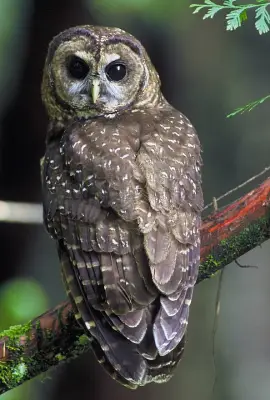
- Scientific Name: Strix occidentalis
Spotted owls are species of true owls. True owls or typical owls belong to the Strigidae family and are one of the two generally accepted owl families, together with barn owls.
These nocturnal birds are year-round residents of forested regions in the western parts of the state, found from the coastal mountains to the eastern foothills of the Cascade Range.
Identify spotted owls by their chestnut brown plumage with white and brown spots, white bands on the tails, and dark eyes.
Spotted owls are vocal species that can be most often heard at sunset, early evening, predawn, and dawn.
Out of 13 different hoots, barks, and whistles, their most famous call consists of a series of 4 deep hoots with the middle two notes closest together. Females have higher voices than males and both sexes make the calls to defend their territory.
Due to habitat loss and competition with other owls, their population has been on the decline – the International Union for Conservation of Nature (IUCN) listed spotted owls as Near Threatened species.
12. Great Gray Owl
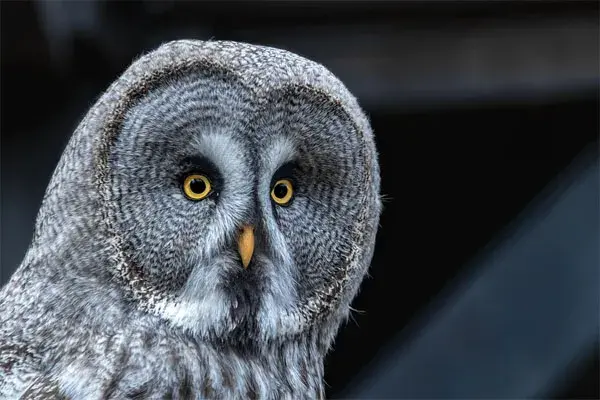
- Scientific Name: Strix nebulosa
Great gray owls are the largest species of owls in Oregon by length. They measure from 24 to 33 inches and are known under several names, including Phantoms of the North, bearded owls, sooty owls, etc.
Patterned with brown and white mottling, streaks, and barrings, great gray owls blend perfectly with the gray-brown bark of their conifer perch. They also have large yellow eyes on their large round heads.
These owls are extremely secretive and hard to find and birders often consider it a huge achievement to get a confirmed sighting.
Great gray owls are uncommon to rare residents in forested areas near clearings above 3,000 feet in the Cascades, Blue, and Wallowa mountains. While they are mostly seen east of the crest in the Cascades, they’ve also been spotted breeding on the west side in the Willamette National Forest.
Great gray owls hoot and hunt at night or around dusk and dawn, mostly catching voles.
Great gray owls are most vocal during the breeding season with pairs making a low-pitched series of “hoos” that last between 6 and 8 seconds and have a 30-second pause between the calls. They will also make soft double hoots when protecting their territories or when humans feed them; females have higher-pitched voices than males.
13. Boreal Owl
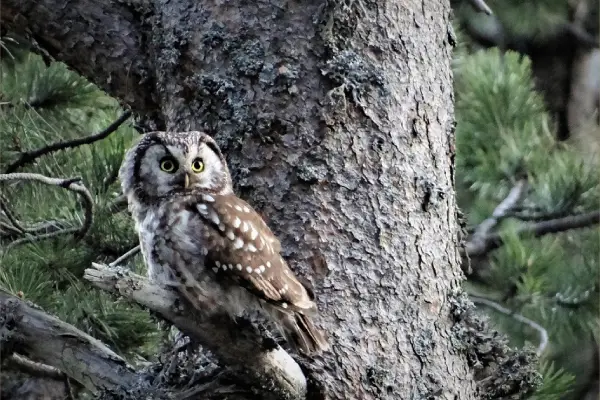
- Scientific Name: Aegolius funereus
In Oregon, these shy, strictly nocturnal owls live in remote, snow-covered mountain forests with few passable roads. They are permanent residents, regularly observed in areas like the Wenaha-Tucannon Wilderness, South Sister Mountain, and various national forests.
Boreal owls are also known as Tengmalm’s owls (after Swedish naturalist Peter Gustaf Tengmalm) and can be identified by their dark brown upperparts, white spots on backs and rumps, conspicuous facial disks, yellow hooked beaks, and yellow eyes.
Males make a series of deep “po-po” toots during the breeding season while females make aggressive “kwahk” calls.
Because of their evasive nature, nocturnal activity, and hard-to-access habitats, boreal owls might be hard to spot. They do not have a very long life either, reaching only 7 or 8 years of age.
14. Pied-billed Grebe

- Scientific Name: Podilymbus podiceps
Pied-billed grebes are small, stocky, and short-necked water birds found throughout the Americas. Just like in Missouri, they are widespread in Oregon and winter locally in open water.
Identify them by their brown plumage that gets darker on the crown and back. Such colors serve as great camouflage but make it harder to spot them.
These birds are commonly found in marshes and ponds with emergent vegetation and are active throughout the night. Listen for their loud, whooping, cuckoo-like song, with pairs sometimes singing together in a duet.
15. Common Poorwill
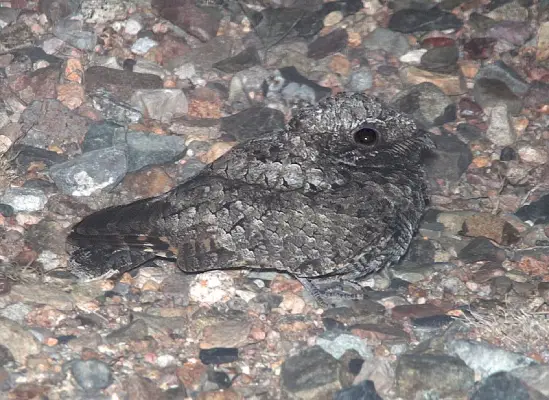
- Scientific Name: Phalaenoptilus nuttallii
- Length: 7.1 in
- Wingspan: 12 in
- Weight: 1.3-2 oz
Common poorwills are nocturnal birds found east of the Cascades, along the Snake, Wenaha, and lower Grande Ronde rivers.
They inhabit dry open areas rich in grasses and shrubs where they nest on the ground and feed on nocturnal insects like grasshoppers, beetles, and moths. Common poorwills will either hunt on the ground or catch them in the air.
These small and compact night birds have grayish plumage, short wings, and tails, got their name after their song that sounds like a whistled “poor-will“.
Common Poorwill Call | Source: National Park Service, Public domain, via Wikimedia Commons
16. Common Nighthawk

- Scientific Name: Chordeiles minor
These medium-sized birds with forked tails and long, pointed wings are crepuscular and nocturnal raptors found throughout Oregon when the summer breeding season comes. They are one of the last birds to arrive in the state and are most abundant in the eastern parts.
Common nighthawks can be seen in prairies, forests, savannahs, and urban areas, and are most active during dawn and dusk with a visible moon. They produce a distinct peent sound and engage in courtship displays with rapid dives creating a booming sound as air passes over wings.
Common Nighthawk Call | Source: Unknown author, Public domain, via Wikimedia Commons
Keep in mind that common nighthawks are well-camouflaged and blend with the environment during the day. Their plumage is usually gray, black, and brown with white patches on their wings close to the base of primary feathers.
17. American Coot
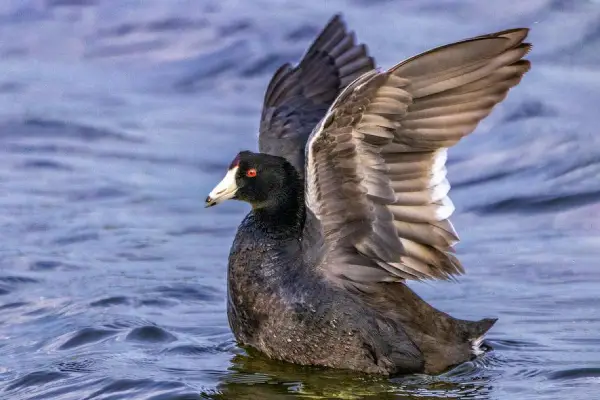
- Scientific Name: Fulica americana
American coots are small chicken-like water birds with black plumage, bright white beaks, red eyes, and yellow-green legs. They also have rounded heads, sloping foreheads, short wings and tails, and large feet.
Although they resemble ducks, American coots are only distantly related to them. These permanent residents of Oregon can be seen and heard in freshwater wetlands with open water and emergent vegetation around dawn and dusk. They have the largest Oregon breeding population of any waterfowl.
American coots produce a sharp “poot” call and a screeching “kree” sound, and they are particularly noisy swimmers, so you may also recognize them by splashing water sounds.
Read More: List of nocturnal birds in Virginia
18. Virginia Rail

- Scientific Name: Rallus limicola
Virginia rails are compact aquatic birds characterized by their brown plumage, which is notably darker on their backs and crowns. They also possess distinctive orange-brown legs and bills.
In western Oregon, they breed in freshwater and brackish marshes, while in eastern Oregon, they are found in large marshes of Klamath, Lake, and Harney counties. They often make harsh “kuk-kuk-kuk” calls during the night; their “grunt” calls can be used for communication between mates.
To navigate dense vegetation, they have developed a body with lateral compression and robust forehead feathers that can withstand the abrasion of pushing through the thick growth. Very secretive by nature, they are more often heard than seen.
They are often found together with soras; short-billed soras feed on seeds, while the long-billed Virginia rails mostly consume insects.
Read More: What birds sing at night in Tennessee?
19. Sora

- Scientific Name: Porzana carolina
Soras are small waterbirds found during summer throughout the state. They can be identified by their short yellow beaks, dark-marked brown upperparts, blue-gray faces and underparts, and black and white barrings on the flanks.
Soras are common around wetlands containing cattails and patches of open water; their descending “whinny” call is used by mated pairs and when establishing territories. They also have a “ker-wee” call for attracting mates and are most active during dawn and dusk.
Sora Call | Source: Jonathon Jongsma, CC BY-SA 3.0, via Wikimedia Commons
The best times to spot soras are early in the mornings or late in the evenings when they’re more likely to come out from the thick plants in search of food.
Read More: What birds sing at night in Indiana?
20. American Bittern

- Scientific Name: Botaurus lentiginosus
American bitterns are wading birds from the heron family. These well-camouflaged solitary birds breed east of the Cascades and spend winters throughout Oregon, except for the Blue Mountains. They are mainly nocturnal with most of the activity happening around dusk.
These birds prefer large cattail or sedge marshes and wet meadows, More often heard than seen, American bitterns have a distinctive booming call that resembles a congested pump that people describe as “oong-kach-oonk.“
American Bittern Call | Source: Alejandro Erickson, CC BY-SA 3.0, via Wikimedia Commons
Read More: Common birds you can hear at night in Ohio
21. Least Bittern

- Scientific Name: Ixobrychus exilis
Least bitterns are one of the smallest heron species in the world. They are rare spring and summer residents in larger freshwater marshes of eastern Oregon with some smaller populations found in the Rogue and Willamette valleys.
Identify them by their long legs, daggerlike bills, and orange, black, and white plumage. They are more active at dawn and dusk and less vocal in windy or rainy conditions. Males can be recognized by their soft “coo-coo-coo” and “reek-reek-reek” calls.
Least Bittern Call | Source: Niels Krabbe, CC BY-SA 3.0, via Wikimedia Commons
Read More: List of night birds of South Carolina
22. Black-crowned Night Heron
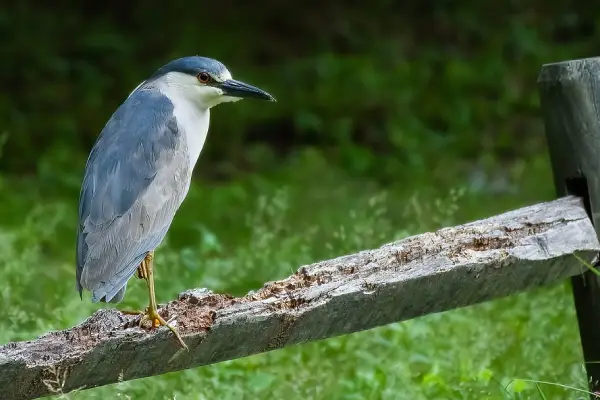
- Scientific Name: Nycticorax nycticorax
Black-crowned night herons, also known as black-capped night herons, are one of the most widespread heron species in the world.
They can be seen east of the Cascades during the summer breeding season. Look for them around wooded swamps, ponds, lakes, and mangroves.
Unlike most of their heron relatives, black-crowned night herons are most active at night or dusk. They will often bait fish – throw some food in the water to lure the prey before striking with their long beaks.
These nocturnal and noisy herons will also migrate in large flocks exclusively during the night. Part of their scientific name “Nycticorax” comes from ancient Greek and means “night raven”, referring to their nocturnal feeding habits and croaking crow-like calls.
Black-crowned Night Heron Call | Source: Jonathon Jongsma, CC BY-SA 3.0, via Wikimedia Commons
Read More: Most common night birds in Arkansas
23. Northern Mockingbird
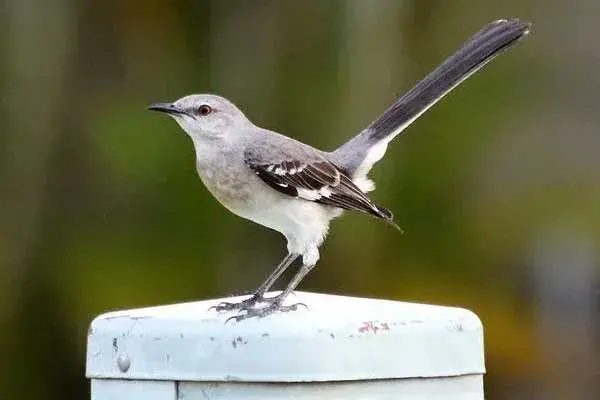
- Scientific name: Mimus polyglottos
Northern mockingbirds are usually the ones responsible for late-night singing sessions you hear in Oregon.
The birds that sing through the night are often young, unattached males or older males without a mate. To stop their constant singing, you can try adding bird nets on your trees or attracting a female mockingbird to your backyard.
They are year-round residents of Oregon, seen in all sorts of habitats. The Latin name of these birds translates to “many-tongued mimic,” and for a reason – northern mockingbirds can imitate chirps of up to 35 species and learn over 200 different songs in their lifetime!
They can mimic sounds of rusty hinges, car alarms, cackling hens, and dog barks; they can mimic so well that it’s hard to tell a difference even with an electronic analysis.
Northern mockingbirds have four recognized calls: the nest relief call, hew call, chat, and the begging call.
Northern Mockingbird Call | Source: Sandtouch Limited Company, a Texas limited liability company, CC BY 3.0, via Wikimedia Commons
You will easily identify them in person by their gray plumage with whitish underparts and long tails. In case you see one while it’s flying, notice the large white patches on its black wings and tails.
Read More: What birds can be heard singing during the night in Texas?
24. Yellow-breasted Chat

- Scientific Name: Icteria virens
These large songbirds have olive-green plumage, bright yellow breasts, and bold face markings.
Yellow-breasted chats migrate to Mexico and Central America during winter but can be often heard singing in the morning and evening during summer in Oregon. They will also even sing at night during the height of their breeding season (May to July).
Often heard than seen, they are common around dense, brushy areas and hedgerows. These birds have a unique mix of cackles, clucks, whistles, and hoots in their songs, along with harsh “chak” calls.
Yellow-breasted Chat Song | Source: Jonathon Jongsma, CC BY-SA 4.0, via Wikimedia Commons
They can mimic other birds, sometimes confusing birdwatchers. During the breeding season, they become more conspicuous, singing from exposed spots and flying openly while gurgling their songs.
Read More: List of nocturnal birds of Connecticut
25. Killdeer

- Scientific Name: Charadrius vociferus
Killdeers are very common birds of Oregon. They are widespread and can be seen during spring and throughout the state, in open areas such as sandbars, mudflats, grazed fields, and even urban areas.
Identify them by their brown plumage above with two black breast bands, orange tails, pink legs, and slender wings with conspicuous white wing stripes at their base.
Killdeers are active during both day and night, and you can often hear them calling above in the dark, especially in early spring and late summer. Mall parking lots and well-lit ball fields appear to be popular spots for their nighttime activities, which involve a lot of socializing, calling, and searching for food.
They got their name from the loud piercing calls that sound a little like “kill-deer, kill-deer”.
Killdeer Call | Source: Unknown author, Public domain, via Wikimedia Commons
These birds are masters of distraction that might fake a ‘broken-wing‘ display where they flutter along the ground in a show of injury, to distract predators from their nests.
What Birds Sing At Night In Oregon?
The most common birds that sing at night in Oregon are the northern mockingbirds.
Mockingbirds singing all night are often young, unattached males or older males without a mate. In case you want to stop their nighttime singing, try to cover your tree with bird netting or attract a female mockingbird to your yard.
You might have also heard yellow-breasted chats singing in the darkness as they call out to the females, or even barn owls and their bone-chilling screams.
Read More: Night singers from Oklahoma
Summary
Oregon’s rich avifauna is brimming with nocturnal birds. Some can be seen year-round there, like several owl species and northern mockingbirds, while others, like yellow-breasted chats and common nighthawks, visit the state only to breed.
In case you’ve stumbled upon or heard any of these birds, we hope this guide helped you identify which ones they were.
Feel free to read our other popular articles on night birds found in New York and night birds found in Georgia.